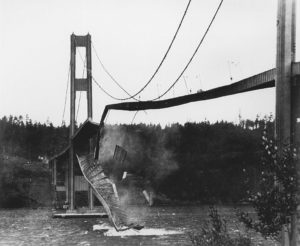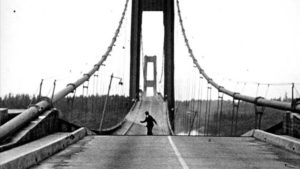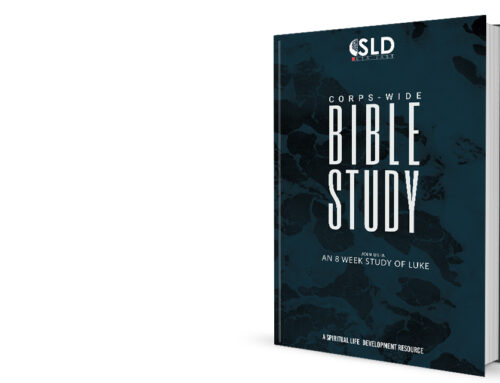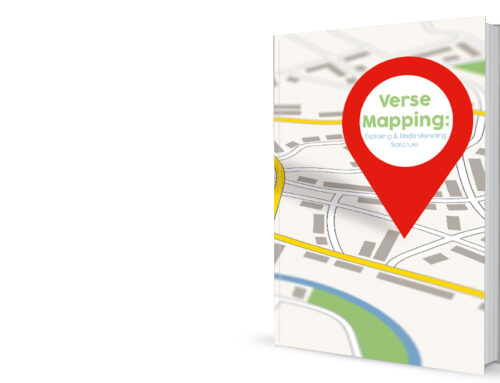 On July 1st, 1940, the Tacoma Narrows Bridge opened to the public. It was the 3rd largest suspension bridge in the world and it spanned Puget Sound’s Tacoma Narrows Straight. The bridge was nicknamed, Galloping Gertie, due to the way it swayed in the wind. A faulty design led to its destruction in 35 mph winds just 4 months later on November 7th, 1940.
On July 1st, 1940, the Tacoma Narrows Bridge opened to the public. It was the 3rd largest suspension bridge in the world and it spanned Puget Sound’s Tacoma Narrows Straight. The bridge was nicknamed, Galloping Gertie, due to the way it swayed in the wind. A faulty design led to its destruction in 35 mph winds just 4 months later on November 7th, 1940.
The phenomenon of resonance affirms that every object has a natural vibration frequency. When waves vibrate around an object at the same frequency, its vibration becomes amplified. When an opera singer hits a high note, the sound waves vibrate at the right frequency and shatter the glass. Ten years after the collapse, the Tacoma Narrows Bridge was reconstructed with open triangles in the undergirding. This enabled winds to pass through the structure as a type of safeguard for any resonance.

In the chapters leading up to our passage, we find Jesus teaching in the synagogue in Capernaum (Luke 4) when a man with an impure spirit enters. Jesus exorcises the demon and the people are amazed. Jesus goes on to heal Simon’s mother-in-law and a man with leprosy. Naturally, word spreads and by chapter 6, Luke tells us people from all over the region are coming to Jesus and being healed of their diseases. Luke, the only Gentile Gospel writer, has set the stage for what is to come next, the account of The Faith of the Centurion as found in Luke 7:1-10.
“After He had finished all that He had to say in the hearing of the people, He went to Capernaum. 2 Now a Roman centurion’s slave, who was highly regarded by him, was sick and on the verge of death. 3 When the centurion heard about Jesus, he sent some Jewish elders to Him, asking Him to come and save the life of his slave. 4 When they reached Jesus, they pleaded with Him earnestly to come, saying, “He is worthy for You to do this for him, 5 because he loves our nation and he built us our synagogue at his own expense.” 6 And Jesus went with them. But when He was near the house, the centurion sent friends to Him, saying, “Lord, do not trouble Yourself further, for I am not worthy for You to come under my roof. 7 Therefore I did not even consider myself worthy to come to You. But just speak a word, and my slave [pais] will be healed. 8 For I also am a man subject to authority, with soldiers under me; and I say to this one, ‘Go,’ and he goes, and to another, ‘Come,’ and he comes, and to my slave, ‘Do this,’ and he does it.” 9 Now when Jesus heard this, He was amazed at him, and turned and said to the crowd that was following Him, “I say to you, not even in Israel have I found such great faith as this man’s.” 10 When the messengers who had been sent returned to the house, they found the slave in good health.” Luke 7:1-10
Centurions were professional officers in the Roman military. They had to be literate, have connections and be at least 30 years of age having had many years of experience serving in the military. They were responsible for 80-100 soldiers and known for their harsh discipline. One Centurion nicknamed “Another” was known to break his staff on the back of soldiers and would call for ‘another’ staff to resume the beating.
At the time of this passage, the Jews were living under Roman occupation. According to Luke’s account, the Capernaum synagogue had been built by the centurion based there. When the Centurion heard Jesus was in the area, he asked the Jewish elders to appeal to Jesus to heal his servant.
“Passion is the bridge that takes you from pain to change,” Frida Kahlo.
Up to this point, the chronology of healings recorded in Luke’s Gospel, took place among the Jewish people. The first healing recorded by Luke took place in the synagogue built by the Centurion. With news of Jesus’ miraculous healings traveling all over the region, we can guess the Centurion, being responsible to keep order, was well aware of the happenings in his locality – especially in the synagogue attributed to him. The Centurion asked the Jewish elders to be a bridge between him and Jesus for the healing of his servant.
“A bridge is a meeting place, a possibility, a metaphor.” Jeanette Winterson.
Jesus goes with the elders and when he was not far from the house, the Centurion sent friends to say:
“Lord don’t trouble yourself, for I do not deserve to have you come under my roof. That is why I did not even consider myself worthy to come to you. But say the word, and my servant [pais] will be healed. For I myself am a man under authority, with soldiers under me. I tell this one, ‘Go,’ and he goes; and that one, ‘Come,’ and he comes. I say to my servant, ‘Do this,’ and he does it.” Luke 7:6-8
In referring to the servant, the Jewish elders describe the servant as “highly regarded.” They use the Greek word, “doulos” which refers to an adult slave. Historically, multiple slaves accompanied Roman soldiers into battle to cook and provide care for them. Slaves were expendable. Roman slaves were essentially prisoners of war that could come from any country in the empire. Their value was based on what they could do for their master. They were seen as property; they had no rights; life was abusive and cruelty was commonplace.
In verse 7 we read:
“But say the word, and my servant [pais] will be healed.”
In Luke’s Gospel, the Centurion used the Greek word “pais” for slave. The Matthew account only uses the Greek word “pais.” In Greek, “pais” refers to a slave who is a child. The Centurion’s description of his servant in both Gospels indicates he is speaking about a child who is a slave.
The society we live in often devalues people and considers some more expendable than others. In a fallen world, we allow society to define and determine our worth. In the context of this story, the Centurion is so troubled that he steps out of his societal and cultural norms to reach out to Jesus.
Luke takes us on an ever-deepening spiritual journey in his writing. Luke’s setup of this encounter between the Centurion and Jesus began with Jewish people who would have commonly been marginalized by their patriarchal society: the demon possessed man in the Capernaum Synagogue, Simon’s mother-in-law and a man with leprosy. The Centurion’s request is essentially asking if Jesus’ ministry is expansive enough to include those outside of Judaism, to include Gentiles. Not only is the Centurion asking about the inclusion of Gentiles, but the marginalized who represent the lowest social order, the slave who is a child.
Willie Jennings proposed that, “reforming our understanding of the person and activity of Jesus in his particular place and time will reveal a social vision of diversity within unity, reconstituted within and around the body of Jesus Christ, and held together by the Holy Spirit.”
For it is, “In the body of Christ there is particularity without division, universality without domination. This is the new space created at Calvary and it is a space that transcends and subsumes time from within. May the Church always be found there.” Michael Yorke
“Jesus was amazed.”
Luke 7:9
 The Tacoma Narrows Suspension Bridge collapsed due to flaws in its original design. The re-designed bridge took into account forces invisible to the eye whose power destroyed the original bridge. After 70 years, the redesigned Tacoma Narrows Suspension Bridge remains standing today.
The Tacoma Narrows Suspension Bridge collapsed due to flaws in its original design. The re-designed bridge took into account forces invisible to the eye whose power destroyed the original bridge. After 70 years, the redesigned Tacoma Narrows Suspension Bridge remains standing today.
In a way, the Centurion wasn’t supposed to be a bridge, but he became a bridge. Our propensity to place value on people only for what they can do for us, to diminish those who are different in language, ethnicity, culture or social order illuminates the sinful flaw in all of us. Compassion for the slave child motivated the Centurion to build a bridge to Jesus. Yet the encounter with Jesus is a lesson of the sacredness of human life, for it exposed the Centurion’s need for a bridge.
Jesus is the bridge.
“The wind blows wherever it pleases.
You hear its sound, but you cannot tell where it comes from or where it is going.
So it is with everyone born of the Spirit.”
John 3:8
John Legend, Bridge Over Troubled Water
written by Major Brenda Suarez, Private Secretary to the Territorial Commander, USA East




